![]()
![]()
![]()
Use LEFT and RIGHT arrow keys to navigate between flashcards;
Use UP and DOWN arrow keys to flip the card;
H to show hint;
A reads text to speech;
111 Cards in this Set
- Front
- Back
- 3rd side (hint)
|
Oropharynx |
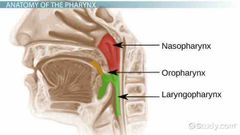
The part of the airway into which the mouth leads. Helps in the swallowing phase. |
|
|
|
An/o |
Anus |
|
|
|
Anastomosis |
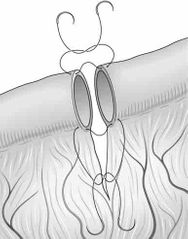
An opening between two separate structures or spaces. This opening is made traumatically, surgically, or pathologically. |
|
|
|
Append/o |
Appendix |
|
|
|
Appendic/o |
Appendix |
|
|
|
Ascites |
Unusual amount of buildup fluid in the abdomen. |
|
|
|
Bariatric |
The study, treatment, and prevention of obesity. |
|
|
|
Bile |
A yellow orange fluid produced by the liver. |
|
|
|
Cachexia |
Weight loss and tissue wasting caused by a serious illness. |
|
|
|
Chol/e |
Bile |
|
|
|
Cholangi/o |
Bile vessel |
|
|
|
Cholecyst/o |
Gallbladder |
|
|
|
Choledoch/o |
Common bile duct |
|
|
|
Col/o |
Colon (large intestine) |
|
|
|
Colon/o |
Colon (large intestine) |
|
|
|
Common bile duct |
A tubular structure that allows the passage of excretions and secretions. |
|
|
|
Cystic Artery |
A branch at the right of the hepatic artery that supplies oxygenated blood to the gallbladder. |
|
|
|
Cystic Duct |
It is connected to the gallbladder and it helps with the transportation of bile to and from the gallbladder. |
|
|
|
Deciduous |
Not permanent; eventually falls off. |
|
|
|
Defecation |
The discharge of feces from the rectum. |
|
|
|
Deglutition |
The process/act of shallowing. |
|
|
|
Dia- |
Complete; through |
|
|
|
Docho- |
Bladder |
|
|
|
Duoden/o |
Duodenum |
|
|
|
-ectomy |
Removal; excision |
|
|
|
Emesis- |
Vomiting |
|
|
|
Enter/o |
Intestine (usually small intestine) |
|
|
|
Esophag/o |
Esophagus |
|
|
|
Excision |
The act of cutting out. |
|
|
|
Falciform Ligament (Broad Ligament) |
A fold of peritoneum that is attached to the lower diaphragm, liver and anterior abdominal wall. |
|
|
|
Fecalith |
A hard mass of thick feces. |
|
|
|
Femoral |
Pertaining to the femur or thigh. |
|
|
|
Flatus |
Gas or air in the GI tract. |
|
|
|
Gastr/o |
Stomach |
|
|
|
Glisson’s Capsule |
A cartilaginous, fatty, fibrous, or membranous structure enveloping another structure. |
|
|
|
Hepat/o |
Liver |
|
|
|
Hepatic Portal System |
Responsible for moving blood from the GI tract to the liver. |
|
|
|
Hiatal Hernia |
Protrusion of the stomach through the esophageal hiatus of the diaphragm. |
|
|
|
-iasis |
Abnormal condition |
|
|
|
Ile/o |
Ileum |
|
|
|
Incision |
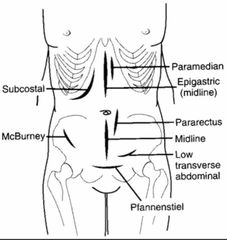
A cut made by a sharp instrument |
|
|
|
Inguinal |
Pertaining to the groin. |
|
|
|
Jejun/o |
Jejunum |
|
|
|
Lysis |
Breakdown; destruction |
|
|
|
-megaly |
Enlargement |
|
|
|
Necrosis |
Death of cells through injury or disease. |
|
|
|
-oma |
Tumor; mass |
|
|
|
-orexia |
Appetite |
|
|
|
-ostomy |
New opening |
|
|
|
-otomy |
Cutting |
|
|
|
Pancreat/o |
Pancreas |
|
|
|
Parietal |
Pertaining to the wall or cavity of an organ. |
|
|
|
-pepsia |
Digestion |
|
|
|
Peri- |
Surrounding |
|
|
|
Peristalsis |
The movement of the intestine or other tubular structures. |
|
|
|
Peritoneum |
A serous membrane that lines the walls of the abdominal cavity and folds inward to enclose the viscera. |
|
|
|
-phagia |
Swallowing |
|
|
|
Pharyng/o |
Throat (pharynx) |
|
|
|
-prandial |
Meal |
|
|
|
Pringle Maneuver |
Securing the hepatic pedicle with a clamp during resection to decrease blood loss. |
|
|
|
Proct/o |
Anus; rectum |
|
|
|
Pylor/o |
Pylorus; pyloric sphincter |
|
|
|
Rect/o |
Rectum |
|
|
|
-rrhea |
Flow; discharge |
|
|
|
Rule of 5s |
If the patient has more than five or five support lines the patient needs to be placed in the ICU and is in critical condition. |
Five lines (foley, ECMO, NG tube, TD drip, & central line) |
|
|
Sclerosis |
A thickening or hardening of a body part especially from excessive formation of fibrous tissue. |
|
|
|
Sial/o |
Saliva |
|
|
|
Sigmoid/o |
Sigmoid Colon |
|
|
|
-stasis |
To stop |
|
|
|
Sub- |
Under; below |
|
|
|
Stenosis |
An unusual contraction an opening or passage |
|
|
|
Triangle of Calot |
includes the common hepatic duct, the cystic duct, and the inferior edge of the liver. |
|
|
|
Ulcer |
Cutting of the surface of an organ or tissue. Produced by inflamed necrotic tissue. |
|
|
|
Viscera |
Soft internal organs of the body especially the organs in the abdominal and thoracic cavity. |
|
|
|
Visceral |
Pertaining to the viscera |
|
|
|
Labia |

Pertaining to the lips. Used to hold liquids and food inside. |
|
|
|
Buccal Space |
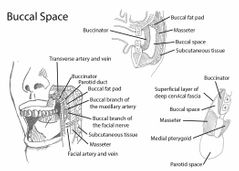
Space in the cheek, and is paired on each side. This muscle helps with mastication movements.
|
|
|
|
Teeth |
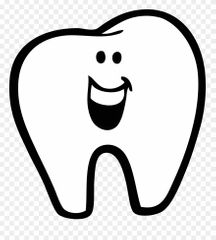
Bony structures of the upper and lower jaws. Used for chewing. |
|
|
|
Mouth |
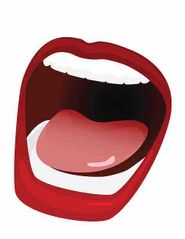
Oral cavity. Where the chewing of food takes place. |
|
|
|
Tongue |
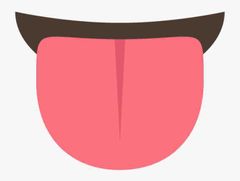
Muscular organ on the bottom of the mouth. Helps with chewing and swallowing . |
|
|
|
Soft Palate |
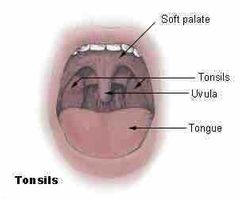
Structure that separates the mouth from the pharynx. It closes off the cavity of the nose from the mouth during swallowing. |
|
|
|
Hard palate |
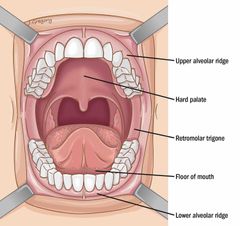
Bony anterior portion of the palate. Provides structure in the mouth and allows the tongue to move freely. |
|
|
|
Fauces |
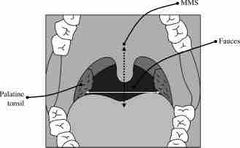
Area between oral cavity and pharynx. Makes it easier to breathe while chewing. |
|
|
|
Fauces |
Area between oral cavity and pharynx. Makes it easier to breathe while chewing. |
|
|
|
Fauces |
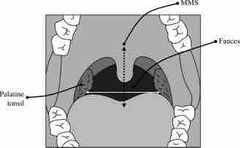
Area between oral cavity and pharynx. Makes it easier to breathe while chewing. |
|
|
|
Oropharynx |
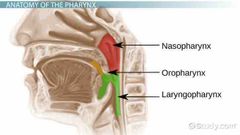
The part of the airway into which the mouth leads. Helps in the swallowing phase. |
|
|
|
Fauces |
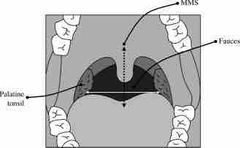
Area between oral cavity and pharynx. Makes it easier to breathe while chewing. |
|
|
|
Oropharynx |

The part of the airway into which the mouth leads. Helps in the swallowing phase. |
|
|
|
Epiglottis |
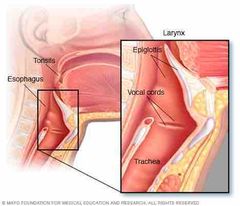
Elastic cartilaginous structure located at the root of the tongue. Prevents (closed) from food and liquids to enter the trachea. |
|
|
|
Upper Esophageal Sphincter |
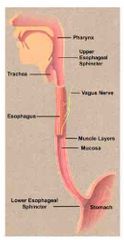
The opening between the posterior pharynx and the proximal esophagus. It’s usually closed but opens to allow the foods and liquids to pass down. |
|
|
|
Esophagus |
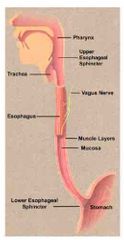
The muscular tube by which food passes from the pharynx to the stomach by muscular waves (contractions). |
|
|
|
Lower Esophageal Sphincter |
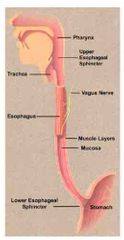
Smooth muscle fibers at the beginning of the esophagus and stomach. Allows food to enter the stomach and prevent reflux of the contents. |
|
|
|
Stomach |
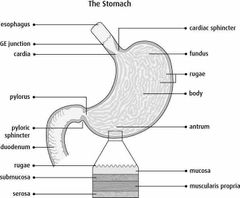
Saclike organ and is one of the principal organs of the digestion system. It’s helps with temporary storage for food, mixing and breakdown of food, and digestion of food. |
|
|
|
Pyloric Sphincter |

Smooth muscle fibers around the opening of the stomach. Allow the food contents to enter the duodenum. |
|
|
|
Small Intestine |
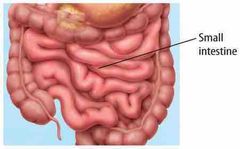
The narrow upper part of the intestine. Digestion is completed her and nutrients are absorbed by the blood. |
|
|
|
Duodenum |
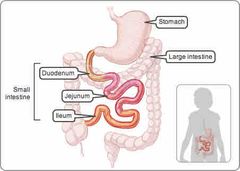
The beginning portion of the small intestine, starting at the lower end of the stomach. It takes juices from the pancreas and liver to help with the digestion process. |
|
|
|
Jejunum |
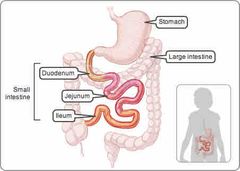
Structure between the duodenum and leads to the ileum. Absorb sugars, amino acids, fatty acids and remaining nutrients that were not absorbed in the duodenum. |
|
|
|
Ileum |

The end portion of the small intestine extending from the jejunum to the large intestine. Absorbs remaining nutrients vitamins, minerals, carbohydrates, fats, and proteins. |
|
|
|
Ileocecal Valve |
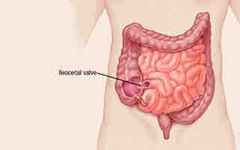
Its function is to allow digested materials to pass from the small intestine into your large intestine. |
|
|
|
Cecum |

The large pouch at the beginning of the large intestine. Absorbs fluids and salts that remain and mixes the contents with a lubricating mucus. |
|
|
|
Large intestine |
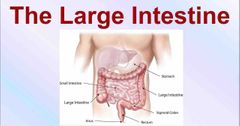
Lower part of the gut, includes the caecum, appendix, colon and rectum. Absorb water and salts from the non digested material and get rid of any waste. |
|
|
|
Ascending Colon |
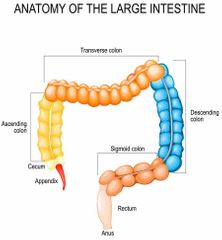
Absorb the remaining water and nutrients from the indigestible material, solidifying it to form stool. |
|
|
|
Hepatic Flexure |
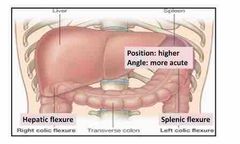
The bend of the colon under the liver. |
|
|
|
Transverse Colon |

The part of the colon between the right and left colic flexures. Absorbs water and salts. |
|
|
|
Splenic Flexure |
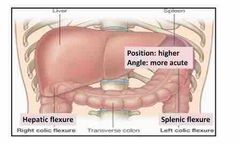
The bend between the transverse and descending colon. |
|
|
|
Descending Colon |
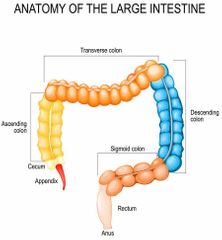
Stores feces that will be emptied into the rectum. |
|
|
|
Sigmoid Colon |
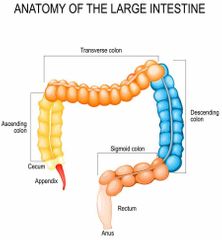
Muscle contracts to increase the pressure inside the colon, causing the stool to move into the rectum. |
|
|
|
Rectum |
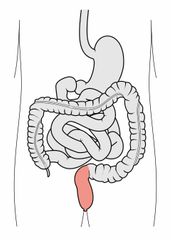
Holds the feces awaiting elimination by defecation. |
|
|
|
Internal Anal Sphincter |
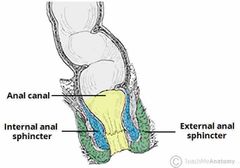
A muscular ring surrounding the lower end of the rectum. Ensures that the anal canal is closed at rest. |
|
|
|
Anal |
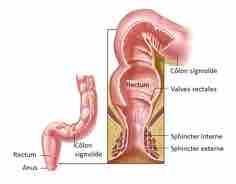
Pertaining to the anus. Prevents stool from coming out when it’s not supposed to. |
|
|
|
External Anal Sphincter |
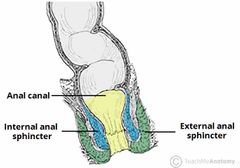
Provides voluntary control for defecation. |
|

